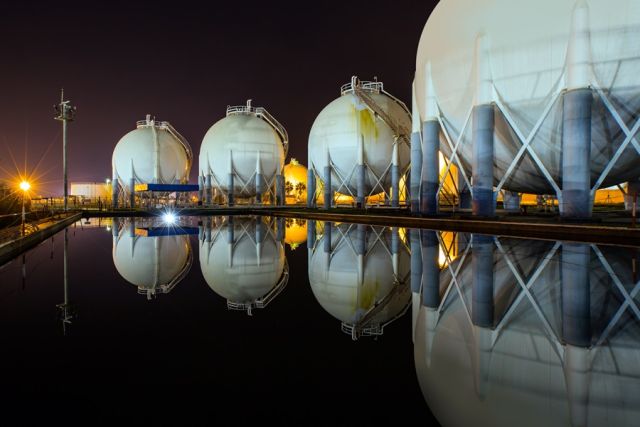
After regularly setting production records in 2023, analysts expect E&Ps to slow production as prices drop and wait for new LNG export facilities to come online. (Source: Shutterstock.com)
The U.S. produced an average of 126.3 Bcf/d of natural gas in October, the highest monthly average recorded since the U.S. Energy Information Administration began keeping records in 1980.
The new high mark followed trends over the last year. Going back to October 2022, production records were set in five of the 12 months leading up to October 2023, including a new high average of 125.5 Bcf/d in September 2023.
Texas led all states, producing an average of 34.7 Bcf/d in October, while Pennsylvania was second with an average of 20.6 Bcf/d.
Some analysts said it was unlikely production would remain at highs. Instead, producers are positioning themselves to withstand a period of low natural gas prices in 2024 before emerging markets — namely LNG— increase demand in the latter half of the decade.
The Henry Hub natural gas spot price average for November 2023 was $2.71/MMBtu compared to $5.45/MMBtu in November 2022. Thanks to 2023’s warm winter and record production, Lower 48 natural gas in storage on Dec. 22 was 3,490 Bcf, at the upper range of the five-year-average, according to the EIA.
Producers remain in a waiting game as U.S. LNG export bottlenecks persist.
“With (LNG export facility) Golden Pass now postponed until 2025 and the recent collapse in natural gas prices, we anticipate declining activity/production in dry gas basins,” Zack Van Everen of TPH&Co. Equity Research wrote in a Jan. 3 commentary. “This decline will be driven by producers building DUC inventories and reducing rig counts.”
LNG export capacity in the U.S. is capped at about 11.4 Bcf/d, according to the EIA, even as demand for LNG in Europe and Asia remains strong. New facilities opening along the Gulf Coast, such as the Golden Pass in Port Arthur, Texas, and Plaquemines in Louisiana, are expected to more than double LNG export capacity by 2027.
In 2024, midstream companies are likely to face a difficult market with low commodity prices and declining flow as they also jockey for position in the latter half of the decade.
“Midstream systems across dry gas basins (Williams Cos., Energy Transfer, DT Midstream, Kinder Morgan) are expected to experience declines in 2024,” Van Everen said. “Despite this, investors are likely to position themselves for the demand ramp starting in 2025 and beyond, as 14+Bcf/d of LNG demand is anticipated to be added over the next three years.”
TPH&Co. said other U.S.-based markets for natural gas are increasing in demand, primarily in power generation. Thanks to coal power plant retirements and slowing renewables projects, natural gas will be a favored choice for U.S. power companies facing increased demand, especially from the rising number of data centers.
The future market will favor midstream companies with gas assets, Van Everen said. Energy Transfer, Kinder Morgan, Williams, Targa Resources and Enbridge all own natural gas pipelines and storage.
“In all, we expect the theme of 2024 to be more infrastructure buildouts and M&A as (midstream) companies position themselves to capture the upcoming ramp,” he said.
RELATED: Williams’ $1.95B Deal for Gas Storage Sign of Tightening Market
Recommended Reading
Quantum’s VanLoh: New ‘Wave’ of Private Equity Investment Unlikely
2024-10-10 - Private equity titan Wil VanLoh, founder of Quantum Capital Group, shares his perspective on the dearth of oil and gas exploration, family office and private equity funding limitations and where M&A is headed next.
Sheffield: E&Ps’ Capital Starvation Not All Bad, But M&A Needs Work
2024-10-04 - Bryan Sheffield, managing partner of Formentera Partners and founder of Parsley Energy, discussed E&P capital, M&A barriers and how longer laterals could spur a “growth mode” at Hart Energy’s Energy Capital Conference.
Investor Returns Keep Aethon IPO-ready
2024-10-08 - Haynesville producer Aethon Energy is focused on investor returns, additional bolt-on acquisitions and mainly staying “IPO ready,” the company’s Senior Vice President of Finance said Oct. 3 at Hart Energy’s Energy Capital Conference (ECC) in Dallas.
Exclusive: How E&Ps Yearning Capital can Stand Out to Family Offices
2024-10-15 - 3P Energy Capital’s Founder and Managing Partner Christina Kitchens shares insight on the “educational process” of operators looking at opportunities in the U.S. and how E&Ps looking for capital can interest family offices, in this Hart Energy Exclusive interview.
Twenty Years Ago, Range Jumpstarted the Marcellus Boom
2024-11-06 - Range Resources launched the Appalachia shale rush, and rising domestic power and LNG demand can trigger it to boom again.
Comments
Add new comment
This conversation is moderated according to Hart Energy community rules. Please read the rules before joining the discussion. If you’re experiencing any technical problems, please contact our customer care team.






